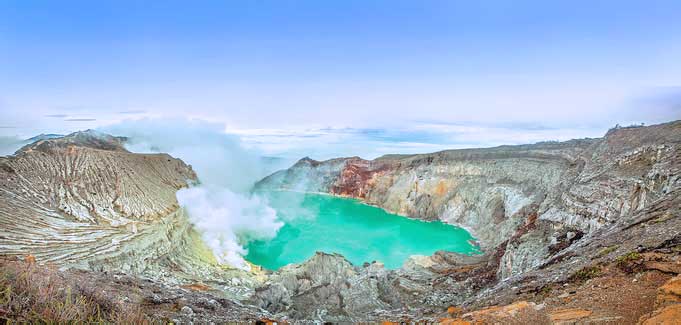
Known as one of the natural miracles on earth that may bring out various travelogues from those who have gone through it in person, Kawah Ijen is the most spectacular volcano in Indonesia regularly frequented by visitors all over the world thanks to its advantages - ease of access, acidic aquamarine lake, unique hard sulphur mining labors and amazing surrounding landscapes.
Located on a plateau of huge ancient caldera between three towering volcanoes in the very eastern tip of Java, Kawah Ijen is one of the stratovolcano groups in Indonesia that culminates at 2,300 meters above the sea level. It is the most stunning volcano in Indonesia, perhaps the only one in the world. It is formed by a series of magmatic eruptions some 3,000 years ago, and the last huge eruption ever recorded was in 1817. The entire plateau covers about 140 km2, the most parts being exploited for coffee plantations, and the rest serving as nature conservation. To the east side, the plateau is backed up by Mount Ijen (2,300 m) and Mount Merapi (2800 m - not to be confused with the one near Yogyakarta) with Mount Raung (3320 m) to the far southwest.

The main purpose of visiting Kawah Ijen is to discover the magnificence of its crater - "a sulfur acidic aquamarine lake by which there is an enormous reserve of natural volcanic sulfur." This is the main zone of sulfur industry in Indonesia optimised by the installation of metal pipes at the exit of each main fumaroles to make faster and more abundant crystallisation. Therefore, the total production can reach 4 to 5 tons of sulfur per day, and the majority is used to refine sugar, to make matches and to produce medicines for skin diseases.



Beside the magnificence of the volcano crater, another aspect that catches a lot of attention of the visitors is the people who work in the sulfur mining up there. Whatever you would call them, "Sulfur carriers", "Sulfur miners" or "Sulfur convicts", they are extraordinarily courageous men. You can imagine ...! For many years these men, most of them from villages around the Ijen plateau, have been working in this hard labour and carrying the sulfur blocks extracted from the crater in appalling condition.
Physically they seem not to be strong enough nor mascular. Simply equipped with two pendulum baskets (and today some equipped with a brake carriage), every day they start working very early in the morning walking for 3km up to the summit, then going down to the crater on a steep path. They are not properly protected and very few possess a mask or glasses, just simple rags to protect themselves from toxic gas. They keep busy breaking the sulfur and preparing their cargo. On the way down of the volcano, as predictable, they are very loaded, between 80 to 90 kg of yellowish rocks on the shoulders. Before going down the hill, they have to leave the crater by climbing up the small painful rocky path. On the halfway, they can take a break to weigh their load. The rules are strict enough - the baskets have to make no less than 60 kg and can go up to 100 kg. Then they continue down to the factory by the parking lot in the valley. They make two trips a day (see three for the youngest). Unbelievable work !


Popularised for the first time by the images of Maurice and Katia Kraft (French volcanologists), and then followed by Nicolas Hulot (French journalist and television reporter) with his reportage about "Sulfur carriers in Kawah Ijen", this place is now very famous for the sulfur mining and sulfur carriers. However, it is not the same as Mount Bromo; it is not exploited for tourists despite so much hikes carried out during the high season between July and September but there is not even a long line of tourists on the way up to the peak. There is no adequate implementation of infrastructures, and the means of transport are still very limited.


Thus, taking a trip to Kawah Ijen while carrying out a pleasant hiking excursion can be of remarkable experience. The climb of two hours and an hour of descent on an easy track despite being steep and slippery on some points seems very accessible even to young children of 7 - 8 years. However, leaving too early for a volcano simply to catch the sunrise is not very good idea for here the sunrise is not as spectacular as the crater itself. However, it is better too not to leave too late in order to avoid the heat of the day. Besides, the sulfur carriers are more numerous before 10 am and the sky is often covered by the end of the morning.





Before getting to the starting point in Paltering, this journey also offers a great stroll in the midst of coffee and clove plantations and luxuriant tropical vegetations like arborescent ferns and others. From the east-side of Ijen plateau facing to the far east-coast of Java, you can also see the island of Bali, beautiful scenery, stunning rice fields and small villages scattered all over the place. So, it's worth a visit !


WANT TO GO TO KAWAH IJEN IN EAST JAVA ?
Whether in one day or two, combining your Bali Trips with hiking in the midst of Kawah Ijen in East Java will simply boost your discovery and experience in this tropical country. It is not necessary to be a good hiker to make this trip combination. Starting the day by visiting some Hindu temples in Bali, it takes you 7-8 hours drive along the southwest coast of Bali with an hour-ferry crossing before you settle into the hotel in Banyuwangi, East of Java. Are you interested ? Check out our form page for a tailor-made trip quote !






